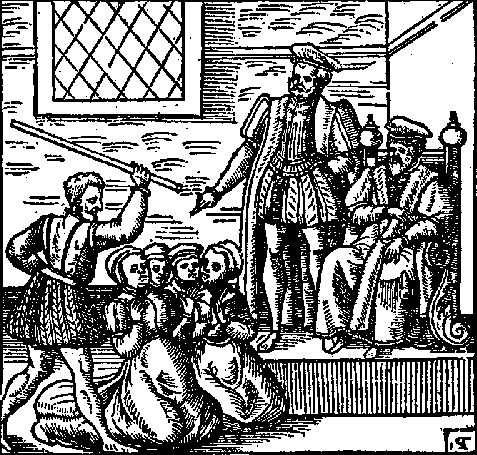
“Now, friends,” I sayt, “I come to another witch, who confessed she was perswaded by the devil to bring about our King’s death. While His Majestie was in Denmark, she and other witches took a cat and christened her.”
“Blasphemious,” screeched some. “An offence to the Queen Cat of Heaven!”
“And if that weren’t enuff,” sayt I, “the witches bound to each part of that cat several joints of a dead man’s body. Then, when they sailed in their sieves as I have told, they conveyed the cat to the middle of the sea and dropped her before the port where the King’s bride had hoped to come ashore.”
More screeches. “You mean they drowned that poor cat?”
“No,” sayt I (though I knew not what befell her). “She swam to land. Then came a great tempest.”
“Sent by the Queen Cat of Heaven!” came calls.
“That tempest wracked a vessel that was sayt to be bringing jewels and other gifts for the new Queen. The christened cat was blamed for it.
“But is that not a cunning way to tell a new wife why she never got nowt? Your gifts were on the boat, my love, but a cat sank it.”
Applauds. I was proud to hear my tale so well-received.
I sayt, “The same witch also confessed that it was the christened cat who caused a contrary wind when our King’s ship came from Denmark.

An illustration from ‘Newes from Scotland’ published 1591.
“Why did the King believe her? He’d heard so many strange things, he called the witches extreme liars. Then the elder witch answered that she would tell him a thing which would leave him in no doubt she spake true.
“Taking the King aside, she told him the verie words which passed between him and his Queen on the first night of their marriage in Norway.
“The King then swore that all the devils in hell could not have known that, and he was inclined to believe that everything the witches sayt was true.
“But tell me this, friends. If all the devils in hell could not have known what was sayt, how could a mere woman? And she no more than the devil’s servant.”
Some called, “The christened cat knew! She told the witches what was sayt.”
“How, friends? Could that cat have swam all the way to Norway and hid herself ’neath their marriage bed?”
“No need for that,” came the reply. “All cats know what men and women say in bed.”
Then they set about calling out such fine phrases as, “Take your cold feet off my leg! You’ve got all the blankitt! Quit snoring! Puh, you stink! Get off me, you drinkard!”
And much else not fit to be set down here.
“Peace, friends,” I called. “I believe you have the right of it. That was the cat’s revenge for being christened, and hung about with rotting flesh, and cast into the sea. She knew the witches would tell the King what she’d told them.”

Some then called for another tale of witchcraft and the King. I never had such praise before, and I thought it would be pleasant to forget Snakes-Purr and my vow of vengeance, and bide here in the countrie.
But I sayt, “Alas, friends, there is none other. After the King got his new witch law, he took against tobacco.”
 The scandalous pamphlet Newes from Scotland was first published in London in 1591. Harry has obviously read it, probably in a copy of King James’ scholarly work Daemonologie where it was reprinted as an appendix.
The scandalous pamphlet Newes from Scotland was first published in London in 1591. Harry has obviously read it, probably in a copy of King James’ scholarly work Daemonologie where it was reprinted as an appendix.
Harry has also put his own spin on the story. Understandably, he concentrates on the confessions of the elder witch (Agnes Sampson) and the cat-christener (Agnes Tompson) rather than the schoolmaster Dr Fian who seems to have been the pamphlet’s main selling point.
In the 1590s witchcraft probably alarmed James’ more than it did in his later life. In Scotland there were witches at every level of society, including among the nobility. His book Daemonologie was first published in 1597 and later reprinted in England.
He wrote it to “ resolve the doubting hearts of many”, and was particularly dismissive of two contemporary writers: Reginald Scot “an Englishman who is not ashamed to deny in public print that there can be such a thing as witchcraft”, and Johann Wier/Weyer, a physician in the Netherlands who opposed the persecution of witches.
Daemonologie is written in the form of a dialogue between Philomathes (“lover of learning”) and Epistemon (“an expert”). Aspects of James himself? Epistemon has all the answers, but Philomathes makes good points, e.g. if witches were capable of causing death there wouldn’t be anyone left in the world who wasn’t a witch.
The scope of the book is wide, covering crimes, punishment, and why some people are more vulnerable than others to devils and demons – either as their servants or their victims.
The English Witchcraft Act of 1604 reflected a little of James’ personal experience. Specific reference was made to digging up dead bodies and using bits of them in witchcraft.

In 1604 James wrote a tract against the taking of tobacco (smoking). “A custom loathsome to the eye, hateful to the nose, harmful to the brain, dangerous to the lungs…” and increased the customs duty on tobacco from two pennies per pound weight to six shillings and sixpence (78 pennies) per pound.
I’m beginning to like James more and more. He was very sensible about tobacco.
LikeLiked by 1 person
He’s a very interesting chap, full of contradictions. And, of course, he’s had an unfair press – partly, I think, because of the near-deification of Queen Elizabeth, and because historians have tended to place too much reliance on the more scandalous accounts of his life and reign.
Off topic, have you come across any books on everyday life in medieval times by Toni Mount? I recently heard her on a “Tudor” podcast and enjoyed her talk. She’s interested in both periods – and commented that she saw the medieval period ending with the dissolution of the monasteries because of the impact on ordinary people, for example.
LikeLiked by 2 people
I’ve heard of her and one of her books has been recommended to me. I like the argument about the dissolution of the monasteries marking the end of the medieval period. They certainly influenced the lives of a good proportion of the population at their height.
LikeLiked by 1 person
Yes – and in the podcast, where Toni Mount ranges over many topics, she made some interesting comments about the poor, the loss of that form of “welfare” and the later development of the Elizabethan Poor Laws. Here’s the link to the podcast I heard.
https://talkingtudors.podbean.com/e/episode-42-talking-tudors-with-toni-mount/
LikeLiked by 1 person
Thank you. I’ll have a listen. The loss of hospitals for the poor is one of the things CJ Sansom mentions in the Shardlake books.
LikeLiked by 1 person
It’s interesting to know that “bed talk” hasn’t really changed much over the centuries.😁
LikeLiked by 2 people
I fear some things never change!
LikeLiked by 1 person
Interesting how even Royals new Better about the negatives about smoking and tried to influence others into avoiding it. Still, sin and profit go hand in hand out doing common sense. 😎😎😎😎😎
LikeLiked by 2 people
True! James might have wanted to stamp out smoking, but he certainly didn’t succeed.
LikeLike
No royal shall ever overcome the influence and endless greed/corruption of Big Business aka Industry/Industrialization. But it is a lovely thought that even a King thought he could do some good for his people. (@—>—)
LikeLiked by 1 person
Fascinating stuff! Love the comment about tobacco.
LikeLiked by 2 people
King James was onto it early.
LikeLike